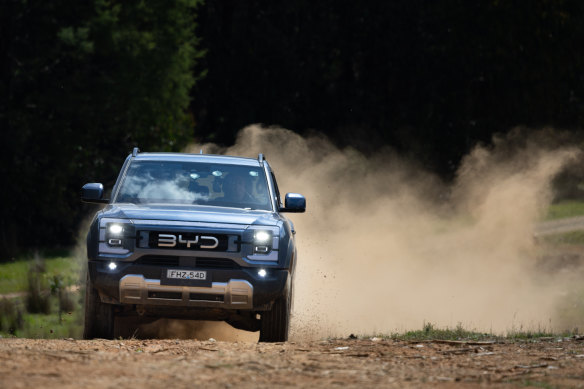- Business
- Consumer affairs
- Electric vehicles
Electric utes ‘won’t end the weekend’. But will they win over Australian drivers?
By Nick Toscano and Mike Foley
Scott Morrison thought they would “end the weekend”. But new electric utes are landing in Australia – and manufacturers insist they have plenty of grunt to tow a boat or trailer and take the family camping.
For years, the iconic utility vehicle has been at the crux of a political debate over the speed of Australia’s transition to cleaner cars, largely due to the common belief that electric vehicles are underpowered compared to traditional petrol or diesel vehicles.

EV maker BYD is launching the first plug-in hybrid electric ute in Australia.Credit: Jason South
Morrison famously suggested former Labor leader Bill Shorten’s plans to hasten electric vehicle uptake would force Aussies to drive wimpy cars that couldn’t hack the country’s tough terrain. As recently as January this year, the opposition invoked the ute once again to try to scuttle the introduction of fuel pollution limits for new vehicles, rules designed to bring Australia in line with every other developed country in the world other than Russia.
“Australians love their utes and SUVs and will not thank a government that forces them to drive less-powerful cars that cannot meet performance expectations,” transport spokeswoman Bridget McKenzie said.
On Tuesday, BYD, China’s best-selling car brand, will unveil the first plug-in hybrid electric ute to hit Australian showrooms: the Shark 6, combining a battery that powers two electric motors and a 1.5-litre four-cylinder petrol engine that can extend the vehicle’s range to 800 kilometres.
It comes as American automaker Ford is also preparing to introduce a plug-in hybrid ute to Australia by next year. The country’s first fully electric ute, the LDV eT60, arrived last year, priced at up to $92,990.
While the Shark’s pricing is to be finalised, David Smitherman, chief executive of Australian BYD distributor EVDirect, said it would be the first electric ute “available to average Australians”. Industry sources rumour it could cost around $60,000, which would make it competitive with Australia’s two top-selling utes: the Toyota Hilux and Ford Ranger.
Of 10,000 Australians who had registered interest in the ute already, most were diesel ute drivers eager to experience an electric vehicle for weekend trips or for work use, including tradespeople who could use the battery to charge power tools, Smitherman said.
“I think there’s a perception often that electric vehicles are slow and sluggish and will ruin your weekend,” he added. “But [the Shark’s] acceleration is 5.7 seconds from 0 to 100 [kilometres per hour] – that’s a heck of a lot faster than most of our rivals.”
Electric Vehicle Council chief executive Samantha Johnson said it was exciting to see more electric utes hitting Australian roads, increasing consumer choice and helping reduce emissions.
She said the federal government’s new vehicle fuel efficiency standards, taking effect from next year, would give motorists an even greater choice of low- and zero-emissions models.
“These vehicles are becoming cost-competitive with traditional petrol models, giving drivers more affordable options that fit their lifestyle and needs,” Johnson said.
After years of sluggish growth, sales of electric vehicles and plug-in hybrids account for nearly 10 per cent of Australia’s new car market. However, adoption of fully battery-electric vehicles has started to slow this year in line with global trends, which analysts attribute to the impact of inflation and worsening cost-of-living pressures. Sales of hybrid and plug-in hybrid vehicles, which are typically cheaper than fully electric models, have increased.
The Market Recap newsletter is a wrap of the day’s trading. Get it each weekday afternoon.